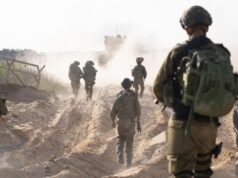Homegrown terrorism has been much discussed on cable news channels and the op-ed pages of major newspapers in recent months. The attention is unsurprising. After all, 2009 saw more homegrown terrorist activity in the U.S. than any other year since the 9/11 attacks, and the phenomenon continues to threaten the country in the new year.
In contrast to 9/11, when all 19 hijackers entered the country from outside the United States, homegrown terrorist attacks are perpetrated by individuals who were either born or raised in the West. There were at least 11 such cases last year, including Nidal Hasan’s shooting rampage at Fort Hood, Texas, another deadly shooting by an Islamic extremist at a National Guard recruiting station in Little Rock, Arkansas, and plots uncovered in Dallas, North Carolina, and the Bronx. These and other examples prompted CNN’s esteemed terrorism analyst, Peter Bergen, to say in December 2009 that when it comes to homegrown terrorism, “there is no denying it is increasing.”
A Long Line of Precedents
Some commentary on the new rash of terrorism cases takes a rather ahistorical perspective. Homegrown jihadist terrorism is, in fact, not new: there were prominent cases even before the September 11 attacks. In July 1980, for example, an African-American convert to Islam named Dawud Salahuddin (born David Belfield) donned a mailman’s uniform and brought two special-delivery packages to the home of Akbar Tabatabai, an outspoken foe of Iran’s new theocratic regime. One package was filled with newspapers, while he grasped a pistol inside the other. Salahuddin shot and killed Tabatabai, then fled to Iran—remarkably clearing customs in Geneva even though the FBI had by then identified him as the shooter.
Similarly, a homegrown terrorist was involved in the 1993 World Trade Center bombing: American convert Clement Rodney Hampton-El. And it would not take long after 9/11 for the American public to learn about others. These include the Portland Seven, a group of Muslims from the Portland, Oregon, area who flew to China in the fall of 2001, attempting to enter Afghanistan to fight American forces; Ahmed Omar Abu Ali, valedictorian of the Islamic Saudi Academy high school in Alexandria, Virginia, who was convicted of conspiring to assassinate President Bush; and the Fort Dix Six, who in 2007 plotted to attack U.S. military personnel in Fort Dix, New Jersey.
It is clear that homegrown terrorism is not new. But is it increasing? Peter Bergen’s claim that “there is no denying” the phenomenon’s growth is not only defensible, but represents the conventional wisdom within the field. While Bergen’s view may well be correct, especially in light of the flow of Western recruits to join the Somali jihadist group al-Shabaab (a phenomenon discussed below), there are at least a couple of questions that make the growth in homegrown terror less clear than some believe.
One question that can be raised is whether policing strategies and tactics create the false perception of a growth in homegrown terror. In 2009, plots in North Carolina and the Bronx were disrupted, while Hosam Smadi in Dallas and Michael Finton in Chicago were arrested following separate sting operations. It is possible that an increase in stings, or the decision to make arrests earlier in the process, is fueling the perception of an increase in homegrown terrorism.
Another possibility is that the current rash of homegrown terror cases is an aberration. In a statistical sequence measured over the course of years (such as weather patterns or a baseball player’s career), aberrant sequences will frequently arise. A spike or precipitous decline in numbers does not mean the numerical trajectory will extend indefinitely. For example, an unusually cold May does not mean that July will also be unusually cold. While in the middle of an unusual statistical sequence, it can be hard to have perspective; and in five years, 2009-2010 may seem exceptional in terms of the level of homegrown terrorist activity, rather than the beginning of a new trend.
It is therefore not entirely clear that homegrown terrorism is increasing. Unfortunately, even if we are not seeing the onset of ever-higher levels of homegrown terrorist activity, that does not diminish the threat, nor does it mean that the threat level is not rising.
Terror Networks and the “Long War”
Some observers frame homegrown terrorism as entirely distinct from, and even opposed to, the problem of terror networks. It is logical that some would do this: after all, the word “homegrown” implies something made entirely in Western countries, independent from international terrorism. But there is in fact no sharp divide between homegrown terror and terrorist networks.
Networks draw on a variety of operatives. Some are from the Middle East, South Asia, or Africa; others hail from the West. Today, the most recognizable homegrown terrorist connected to a powerful transnational network is Adam Gadahn, the portly, stuttering al-Qaeda spokesman. Another example is Abu Mansoor al-Amriki (born Omar Hammami), who has become a key figure in Somalia’s powerful al-Shabaab militia. The transatlantic air plot disrupted in 2006, which would have used liquid explosives to blow up a number of flights bound for the U.S. from Britain simultaneously, employed a number of homegrown operatives.
Though networks can make use of homegrown operatives, al-Qaeda has also been encouraging Muslims in the West to strike on their own volition. In a video released in March 2010, Gadahn exalted Nidal Hasan, encouraging other Muslims in “the armies of the unbelievers and apostate regimes” to follow his example.
Indeed, some commentators think jihadi terrorists striking on their own pose a greater threat than traditional networked terrorism. Writing in Foreign Policy in 2008, Marc Sageman claimed that “[t]he individuals we should fear most haven’t been trained in terrorist camps, and they don’t answer to Osama bin Laden or Ayman al-Zawahiri.” Without downplaying the importance of the “self-financed and self-trained” terrorists whom Sageman believes are a greater threat than al-Qaeda, the idea that “leaderless jihad” has supplanted terror networks as a threat is implausible. Networks are uniquely positioned to pair skill sets, financing, and operatives. Unlike operatives working in a leaderless mode, they are able to formulate a long-term strategy, not only trying to organize catastrophic attacks such as 9/11 or the transatlantic air plot, but also waging a sustained campaign.
The power of networks is amplified by the reemergence of terrorist safe havens. The 9/11 Commission concluded that to carry out catastrophic attacks, terrorist groups require sanctuaries that provide them “time, space, and ability to perform competent planning and staff work,” as well as “opportunities and space to recruit, train, and select operatives with the needed skills and dedication.” Afghanistan served as such a safe haven under the Taliban, and today safe havens can be found in Somalia and the tribal areas of Pakistan, while jihadi groups also enjoy a significant foothold in Yemen and Mali.
Though there has been no comprehensive review of the effectiveness of terrorists who attended training camps compared to those who did not, anecdotal evidence suggests that camps make a cognizable difference. The Fort Dix plot, for example, had terrible operational security: plotters brought a video of themselves firing weapons and yelling in a foreign tongue to Circuit City to have it transferred to DVD. “It turns out that terrorism is tougher than it looks,” analyst Emily Hunt wrote in 2006. “The risks of connecting with hardcore militant networks are minimal compared with the risks of operating independently.”
Homegrown Terrorists as Ideal Operatives for Networks
It is clear why homegrown terrorists would be attractive operatives for terror networks. As the New Yorker noted in 2007, “because of their cultural literacy, and because of the mobility that their citizenship provides,” homegrown terrorists “are potentially the most dangerous of terrorists.”
While it is not yet clear that we are seeing a trend toward increased homegrown terrorist activity, we may be seeing homegrowns increasingly connect to international networks. Men like David Headley, Faisal Shahzad, Bryant Neal Vinas, Najibullah Zazi, and the aforementioned Abu Mansoor al-Amriki were all connected to significant transnational networks.
Homegrown terrorism may thus be an increasing challenge to the U.S., and other Western countries, even if it is not growing as explosively as some observers believe. If homegrowns are indeed becoming more connected to transnational networks, they may become more lethal due to the connections that these networks can create, and the opportunities to train and otherwise build an operative’s skills that they provide.
Looking Forward
At the time of the 9/11 attacks, the U.S. was an incredibly wealthy society, and deeply uncomfortable with the idea of unfairly singling out any group (i.e. profiling). Thus, the country took an almost perverse pride in the inefficiency of its anti-terror policing. The search policies that the Transportation Security Administration implemented in airports in the immediate wake of the attacks typify this mindset. The inefficiency of these policies can be glimpsed, for example, in the manner that recognizable politicians—people who clearly posed no terrorist threat—were singled out for additional security screening. Al Gore was twice selected for extra screening during a trip to Wisconsin, while 75-year-old Congressman John Dingell was forced to strip down to his underwear to prove it was his artificial hip, and not a weapon, that had set off a metal detector.
Some pundits use the latest trends to justify continuing with inefficient anti-terror policing. They argue, for example, that the growth of homegrown terror shows that attempting to profile terrorists can never succeed. One problem with this argument is that it has a crude view of profiling, seeing it as synonymous with looking for Arabs, when in fact there are a number of sophisticated techniques—such as behavioral profiling—that can produce significantly better results than random checks. It is not clear that a complex terrorist profile should cause American officials to throw up their hands in desperation, rather than attempt to construct more sophisticated means of assessing possible risks.
It is clear the U.S. is no longer in an era where it can strongly prefer the least effective policing because the scale of resources devoted to the problem can mask the ineffectiveness of these policies. Recent terrorist plots—such as Umar Farouk Abdulmutallab’s attempt to bring down Northwest Airlines Flight 253, and Faisal Shahzad’s attempted bombing on Times Square—show that America’s policing efforts are in fact no longer one step ahead of those trying to harm the country.
When it comes to possibly aberrant statistical sequences, the United States cannot rely upon terrorist incompetence and luck to continue forever.
Daveed Gartenstein-Ross is the director of the Center for the Study of Terrorist Radicalization at the Foundation for Defense of Democracies, and the author of the 2009 study Homegrown Terrorists in the U.S. and U.K.: An Empirical Examination of the Radicalization Process. He is currently a Ph.D. candidate in world politics at the Catholic University of America.





